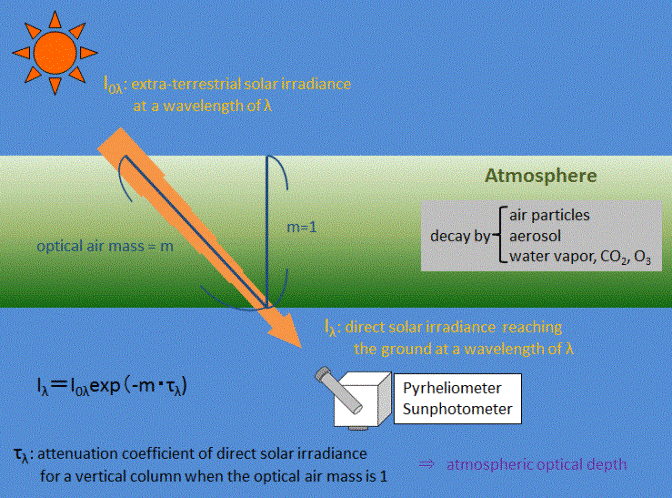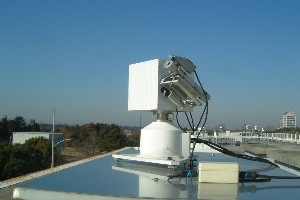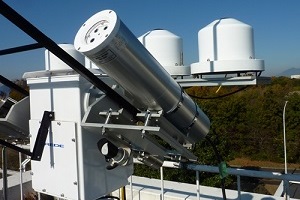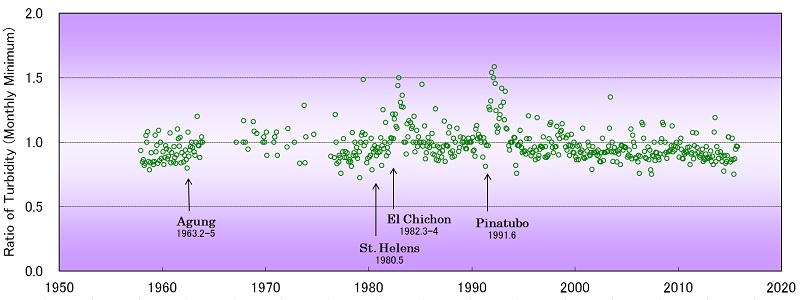Observation of Atmospheric Optical Depth
Principles and theory of measurement
A certain amount of solar radiation is absorbed, scattered and reflected by atmospheric air molecules, aerosols and clouds before reaching the ground, which directly affects the earth's radiation budget. In recent years, direct and indirect radiative forcing by aerosols has been reported to play a significant role in global warming.
The coefficient of attenuation of solar radiation by the atmosphere is called atmospheric optical depth, and can be calculated by measuring the intensity of direct solar radiation reaching the earth. In Tsukuba, the index of solar radiation attenuated by the earth's atmosphere is based on the theory of Feussner and Dubois's turbidity coefficient calculated from direct solar radiation observation. Aerosol optical depth, indicating the attenuation of solar radiation by aerosols, is calculated from direct solar radiation at specific wavelengths as observed using a sunphotometer.

Outline of atmospheric optical depth observation
Observation types
- Atmospheric turbidity coefficient
- Solar energy directly reaching the earth's surface is called direct solar radiation. The atmospheric turbidity coefficient can be calculated from solar irradiance with fine weather conditions (Calculation of Atmospheric Turbidity Coefficients (JMA website)).
- Aerosol optical depth
- The intensity of direct solar radiation at each wavelength is called spectral solar irradiance. Aerosol optical depth can be calculated from spectral solar irradiance with fine weather conditions at the specific wavelength where there is no radiation absorption by water vapor (Observation of Aerosol Optical Depth).
Observation methods
- Atmospheric turbidity coefficient
- Direct solar radiation is observed using a pyrheliometer mounted on a solar tracker to ensure that sun beams are constantly directed to the instrument throughout the year. Atmospheric turbidity is calculated from direct solar radiation observation with fine weather conditions.
- Aerosol optical depth
- Spectral solar irradiance at specific wavelengths is observed using a sunphotometer mounted on a solar tracker to ensure that sun beams are constantly directed to the instrument throughout the year. Aerosol optical depth is calculated from spectral solar irradiance observation with fine weather conditions.

Atmospheric turbidity coefficient observation (pyrheliometer)

Aerosol optical depth observation (sunphotometer)
Observation results
Examples of results from observation at Tsukuba are shown below. The long-term variation of monthly minimum atmospheric turbidity coefficients clearly shows impacts of stratospheric aerosols resulting from volcanic eruptions. The increased turbidity coefficients seen over a period of several years after 1963 and the sudden increases in turbidity observed in 1982 - 1983 and 1991 - 1993 correspond to the eruptions of Mt. Agung (Indonesia) in 1963, Mt. El Chichon (Mexico) in 1982 and Mt. Pinatubo (Philippines) in 1991. The increased turbidity stems from the persistent presence of sulfate aerosols in the stratosphere resulting from the huge amounts of SO2 released by the volcanic eruptions. The turbidity coefficient has now returned to approximately the same level as that observed before the eruption of Mt. Agung because no large-scale eruptions have occurred since that of Mt. Pinatubo.

Long-term variation of monthly minimum atmospheric turbidity coefficient anomalies at Tsukuba